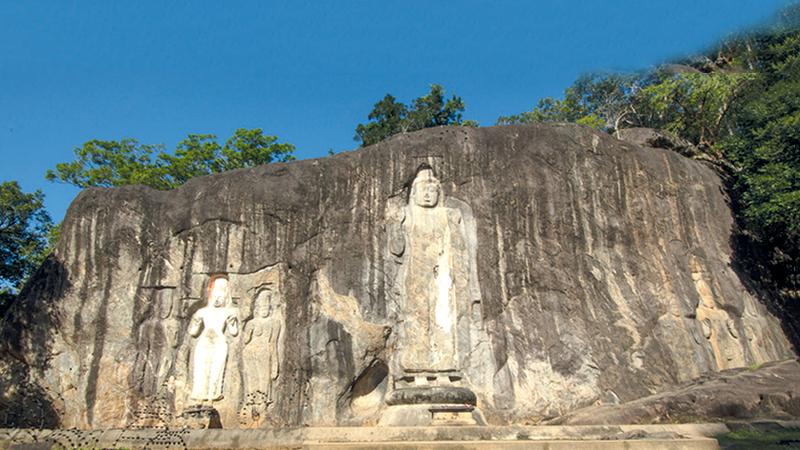
Turning left from the dusty junction of Buduruwagala on the Tissamaharama-Tanamalwila-Wellawaya highway, we drove through a fertile farming village less than three kilometres from Wellawaya in the awe-inspiring mountain range of the Uva Province. Travelling a distance of 2.5 kilometres on a narrow-wooded road, we tried to find our way to the Buduruwagala rock carvings.
 The Buduruwagala rock carvings, a popular tourist destination in the country featured in all its splendour in travel and coffee table books on Sri Lanka, seem to have a gallery of magnificent rock carvings, with seven sculptured colossal figures, located in the heart of the jungle. It is possibly one of the most photographed sites in the island.
The Buduruwagala rock carvings, a popular tourist destination in the country featured in all its splendour in travel and coffee table books on Sri Lanka, seem to have a gallery of magnificent rock carvings, with seven sculptured colossal figures, located in the heart of the jungle. It is possibly one of the most photographed sites in the island.
With a love to explore ancient sites depicting their bygone glory, we drove along the dusty road to Buduruwagala, absorbing the beauty of the remote community, flanked by lush green paddy fields and farmers’ huts as well as some modern houses that were inevitable developments due to commercialisation.
As we entered the forest, the placid tank of Buduruwagala dramatically comes into view through a dark arch of forest canopy. The skeletons of dead trees which still stand and the various birds’ nests on the trees give a serene touch to the scene.
Variety of birds
The water, with its shallow marshy tracts is the perfect feeding and wading habitat for a wide variety of birds. Some of the birds spotted are cormorants, hawk eagles, ebbs and water fowls. During the drought period, herds of elephants could be spotted in the vicinity of the Buduruwagala tank.
Passing the tank, we entered the temple premises of Buduruwagala. The meditating centre and the resting place built by the Tourism Authority are located adjoining the car park, where travellers park their vehicles and walk to the site.
Following the directions to the site we walked about 200 metres under the forest canopy and suddenly, through the trees, we glimpsed the massive, elephant-like rock boulder with carvings. It is filled with fine stretches of vast open plains punctuated by forest trees, chena cultivations and the denuded forest, creating an awe-inspiring spectacle with its mountain frontier. The prominent Vadinahela rises loftily standing like sentinel which could be viewed from all directions.
The Buduruwagala rock carvings on a rock which seems to be in the shape of an elephant is a remarkable sight. A self-appointed ‘guide’ helped us to understand the sculptures.
Here you see a unique assembly of seven figures in high relief, depicting the highly developed artistic skills of 7th century sculptors. At 51 feet, the central Buddha statue is perhaps the tallest in Sri Lanka and has been carved out of the living rock. It is flanked on both sides by two groups of three figures which Prof. Senarath Paranavitarane has stated as a depiction of the Dipankara Buddha.
Artistic skills
 To the right of the Buddha statue is a carving of the Bodhisatva draped in a long garb, wearing a turban and a waist band.
To the right of the Buddha statue is a carving of the Bodhisatva draped in a long garb, wearing a turban and a waist band.
To his left is the beautiful and sensuous Tara Devi, believed to be his spiritual consort strikingly winsome in the thrice bent posture. Her body carved with a narrow waist flares out again into shapely hips and bare bosom. Legend has it that Tara was born of the tears wept by Avalokitheswara for the sufferings of the world. On the right of the Bodhisatva figure is Suddhana Kumara, his constant companion.To the left of the central Buddha statue are three more figures.
The statue at the centre is believed to be a carving of the future Maitriya Buddha and on either side are Vajirapani and Manjusri. There is a deep dent in the centre of the rock in the shape of a huge clay lamp and it is believed that a flame used to be lit here.
A middle-aged person in the temple said when he was a small boy, he had seen oil leaking from the rock cavity and that he used to anoint his head with the oil. At present, the oil is not leaking and the only evidence of oil having leaked before is its discolouration. The area is blackish in colour. Observing the figures, I understood that ancient sculptors had completed in stucco to cover the stone images to achieve a more refined and artistic value to the carvings. Even today, looking at the Bodhisatva image to the right of the Buddha image, we noticed a portion of white plaster on the stone image, and a scanty piece of plaster on the main Buddha statue.
Seeing the gallery of rock-hewn carvings on the isolated rock in a silent forest, we were impressed not only by the serene beauty of the images but also the enchanting greenery of the verdant jungle, the clear waters and shadows of dead trees at the Buduruwagala tank.
